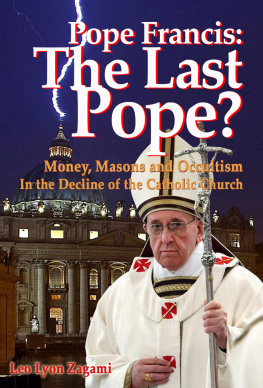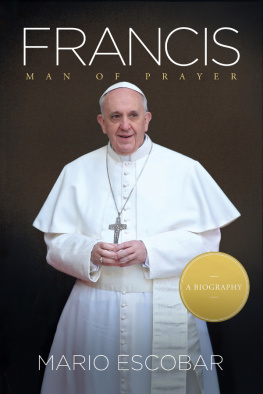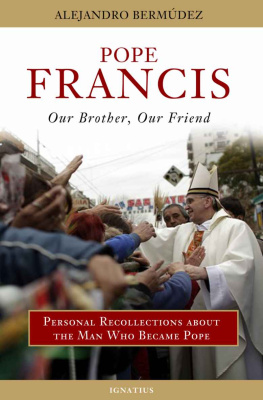FRANCIS
Andrea Tornielli
FRANCIS
Pope of a New World
Translated by
William J. Melcher
IGNATIUS PRESS SAN FRANCISCO
Original Italian edition
Jos Mario Bergoglio. Francesco Insieme
2013 by Edizioni Piemme Spa, Milan, Italy
Cover photo
Pope Francis Waves to the Crowd from Balcony of St. Peters Basilica
Wednesday, March 13, 2013
AP Photo / Dmitry Lovetsky
Cover design by John Herreid
2013 by Ignatius Press, San Francisco
All rights reserved
ISBN: 978-1-58617-852-9
Library of Congress Control Number 2013935552
Printed in the United States of America
To my mother, Eleonora
Contents
Foreword
by Father Mitch Pacwa, S.J.
In my adult years as a priest, the Chair of Peter has been filled four times. The election of John Paul I evoked the usual joy of having a new Holy Father and the hope that the Church might find stability at a time of theological and liturgical turmoil. However, I did not feel particular engagement with the new pope. The shock thirty days later when he died actually made a deeper impression on me than had his election.
The election of his successor got my attention, and I remember well that a radio was broadcasting in the background as I studied, waiting for the announcement of a new pope. When the newscaster said that Karol Wojtyla of Krakow, Poland, was now Pope John Paul II, I raced down the three flights of stairs, perhaps touching a few of them as I ran, carrying a box of chocolates to pass out on the street as I gleefully announced to every passerby, The new pope is Polish! Excitement that a Pole had been chosen swelled my heart with ethnic pride and joy, making Polish jokes and slurs in the past fade into insignificance. However, the twenty-seven-year reign far exceeded ethnic hopes, as his vigor captured everyones attention and a whole new approach to philosophy and theology fired an enthusiasm for the truth of the Catholic faith. From his first year as pope, vocations began to increase and a generation of clergy, religious, and laity would be known as the John Paul II generation. Dissidents on the theological right and left huddled among themselves as Catholicism swelled to a new force in the modern world under John Pauls leadership.
In 2005, I watched the advance of Pope Benedict XVI to Saint Peters balcony with a deeper joy, since it meant that another extraordinary teacher would continue to guide the Church, leaving theological and liturgical confusion farther behind. He focused on Jesus Christ as he quietly, humbly led the Church forward, retaining the love and allegiance of the John Paul generation.
Pope Benedicts retirement came as a jolt but not as a total surprise. His age had advanced, and his strength had waned. This book presents many key insights into Pope Benedicts retirement, and every Catholic will appreciate the mature assessment of a decision that raised much speculation and less wisdom from various pundits inside and outside the Church.
In 2013, the election of Pope Francis evoked another kind of pridea fellow Jesuit, the first one in history, had been elected pope. Certainly Jesuits had spoken of him, since he was not only an archbishop in an important archdiocese, Buenos Aires, Argentina, but also a cardinal. The Constitutions of the Society of Jesus prohibit Jesuits from seeking to be bishops, but the pope can override that rule and choose a Jesuit to belong to the college of bishops, as happened to Father Jorge Bergoglio, S.J. Vague rumors circulated that he was a papabile after John Paul II died, but most Jesuits I knew dismissed them with the generally accepted assumption that a Jesuit would never be pope. I remembered him from 2005, but I thought he might be past the age being sought for a new pope in 2013, since so many people were speaking about the importance of a young pope for the modern world. However, neither his age nor his being a Jesuit hindered him, and Jorge Bergoglio, S.J., walked out on the balcony of Saint Peters as Pope Francis.
As I watched this drama develop, my pride was not exuberant, as when the Pole Karol Wojtyla emerged, but quiet. I stood in the EWTN studio with Franciscan friars, cameramen, fellow hosts waiting to comment, and visitors who formed an audience. Their congratulations to me as a Jesuit could not change my silence; text messages began pouring into my phone, but it was not a time to accept congratulations, especially since I had done nothing but follow the gift of my Jesuit vocation as Pope Francis had done even longer than I.
A peaceful joy deepened as this new popes personality unfolded before the crowd in Saint Peters Square, the whole world, and us in the studio. His simple Good evening, his light comments about being the Bishop of Rome, and especially his bow toward us, that we all might pray for him and bless him before he blessed us for the first time as pope, were a triumph of quiet joy. This moment was followed by many small moments of making ordinary actions quite uncommonriding a bus with the cardinals, praying alone at Saint Mary Major, stopping to pay his bill in person at a Rome hotel for priests, calling the man who delivered his papers in Buenos Aires to cancel the subscription, meeting with the Jesuit Father General Adolfo Nicols, S.J., to accept his offer of Jesuit support to the new pope, and the Popes extension of his apostolic blessing to all Jesuits and those who work with them. These moments stream forth from him, making his office yet more amazing.
Where does all this come from in Pope Francis? What led to the election of a Latin American Jesuit as pope? What is the background against which his first papal acts find their context? Certainly his family is essential, and in this book we get a first glimpse of the people who raised him and their attitudes toward his Jesuit vocation. We learn how the Lord called him from his first career choice to a Jesuit vocation that could incorporate those same talents in ministry rather than career. We will understand the development of his Jesuit life in a period of turmoil and change in the Church and during extraordinarily difficult political circumstances, as the Argentinian government swung to the violent right and a secular left that opposed Church teaching. What were the constants in Padre Jorge Bergoglios ministry and service as a Jesuit and as an archbishop in violent, horrible times? These questions are addressed in this book. In addition, there is invaluable background on Pope Benedicts resignation and the process of electing Pope Francis. May this knowledge of Pope Francis past and background enlighten every reader, not so much as to make the new pope predictable within the confines of the categories stemming from his personal history, but to provide a context for the new surprises he seems capable of offering to the Church and to the modern world as a whole.
Introduction
I ask you to pray for me...
On Wednesday, March 13, 2013, after having witnessed the black smoke in the late morning and eaten my usual meal of vegetables and grilled calamari with my colleagues at Robertos restaurant along the Passetto di Borgo, I left the Vatican to return to the editorial offices of La Stampa on the via Barberini. Ever since newspapers became multimedia websites as well, print journalists have also had to do live television broadcasts and audio-video service. If there is white smoke this evening, the boss had told me, we must immediately do a live streaming broadcast and commentary on the announcement... The cardinals had been shut up in the Vatican for about a day, without any possibility of communicating with the outside; the forecasts of the newspapers and of the various purple-robed prelates spoke about a difficult and uncertain conclave, which would certainly be longer than the one in 2005 that had elected Joseph Ratzinger. For lack of a strong candidate like the Prefect of the Congregation for the Doctrine of the Faith eight years ago, one capable of galvanizing a consensus, the selection of the 266th Bishop of Rome would therefore be longer and more laborious.











